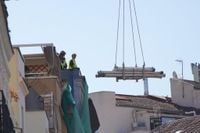On a sunny Tuesday afternoon, disaster struck the heart of Madrid. The city’s vibrant center—just steps from the famed opera house and royal palace—was rocked by the collapse of a six-storey building at No. 4 Hileras Street. The structure, once a 1960s office block, was in the midst of an ambitious transformation into a four-star hotel. Instead, it became the site of tragedy, with four lives lost and a city left searching for answers.
According to Bloomberg and Reuters, the building’s interior structure gave way suddenly on October 7, 2025, sending floors cascading down like dominoes. Miraculously, the building’s facade—preserved as part of the renovation—remained standing. But behind that shell, the devastation was total. Emergency crews rushed to the scene, launching a frantic 15-hour rescue effort that stretched into the early hours of the next day. Drones buzzed overhead, sniffer dogs weaved through dust and debris, and thermal cameras scanned for any sign of life.
By Wednesday morning, the grim toll was clear. Four people had perished: three male construction workers—one each from Ecuador, Mali, and Guinea-Conakry—and a 30-year-old female architect who was leading the project. Their bodies were recovered from the rubble after a night of painstaking work by firefighters and rescue teams. Three others were injured, with one suffering a fractured leg, but authorities said their wounds were not life-threatening. The mayor of Madrid, José Luis Almeida, expressed his condolences on X, writing, “With deep sadness, firefighters have recovered the missing workers.” As reported by AP, he extended sympathy to the families and colleagues of those lost.
Eyewitnesses described a scene of chaos and confusion. One construction worker, Mikhail, had been pumping concrete into the lower floors just before the collapse. “I was the first to run, I didn’t care about anything else. I’ll save my life first and, if I can, save others later,” he told reporters, his voice still shaky from the ordeal. Nearby buildings were evacuated amid fears that more of the structure might give way, and the area—usually bustling with tourists and locals—was cordoned off as a precaution.
The building’s history now looms large in the investigation. Originally constructed in 1965, the property had been flagged for structural concerns in both 2012 and 2022. Municipal inspection records, cited by El País and Construction Briefing, rated it “unfavourable” due to the general condition of its facade, exterior, partition walls, roof, terraces, and plumbing. Despite these warnings, the building was purchased in 2022 for €24.5 million ($28.5 million) by RSR Singular Assets Europe Socimi, a Saudi-based investment fund specializing in high-end hotels and tourist apartments across Spain and Portugal. The redevelopment—entrusted to the renovation firm Rehbilita—was approved by city authorities in December 2024, with work expected to last two years.
Spanish authorities have now launched a full investigation into the cause of the collapse. Police are focusing on two main areas: possible structural weaknesses in the aging building and potential procedural lapses during the concrete pouring operations that were underway at the time. Firefighters are currently stabilizing the remaining facade, allowing forensic teams to safely sift through the debris in search of clues. As AP noted, Spain has a tradition of renovating the interiors of older buildings while maintaining their historic exteriors—a practice that, while preserving the city’s architectural charm, can sometimes complicate construction projects.
For many in Madrid, the collapse has raised uncomfortable questions. Were the previous inspection warnings adequately addressed? Did the rush to transform the property into a luxury hotel lead to shortcuts or oversights? And could this tragedy have been prevented? These are the questions now facing not just investigators, but a city that prides itself on both its history and its forward-looking energy.
According to Reuters, the building’s redevelopment was part of a broader trend in Madrid’s city center, where aging office blocks are being converted into hotels and upscale apartments to meet surging demand from tourists and investors. RSR’s involvement reflects the growing role of international capital in reshaping the city’s landscape. Yet, as this tragedy shows, such projects come with real risks—especially when dealing with structures that may be hiding decades-old vulnerabilities beneath their classic facades.
In the immediate aftermath, local officials moved quickly to reassure the public. Emergency services emphasized the speed and professionalism of their response, while police promised a thorough and transparent investigation. The city’s building safety protocols are now under renewed scrutiny, with some calling for stricter oversight and more frequent inspections of older properties undergoing major renovations.
The human cost, though, is impossible to ignore. The victims—three men who had traveled from Ecuador, Mali, and Guinea-Conakry in search of better opportunities, and a young architect at the start of her career—represent the diverse workforce that powers Madrid’s construction boom. Their loss has left a deep mark on their families, colleagues, and the wider community. As reported by AP, the mayor’s message of condolence was echoed by many across Spain, with tributes pouring in for those who died while simply doing their jobs.
For now, the site at 4 Hileras Street remains a scene of both tragedy and determination. Firefighters continue their painstaking work, stabilizing what’s left of the building and ensuring that no further harm comes to those still working among the ruins. Forensic teams are picking through the debris, looking for answers that may help prevent future disasters. And city officials are vowing to learn whatever lessons they can from this catastrophe, even as they mourn the lives lost.
In Madrid, as in so many historic cities, the tension between preserving the past and building for the future is always present. The collapse at No. 4 Hileras Street is a stark reminder that progress must never come at the expense of safety—and that the true measure of a city is how it cares for those who build it, brick by brick and day by day.



